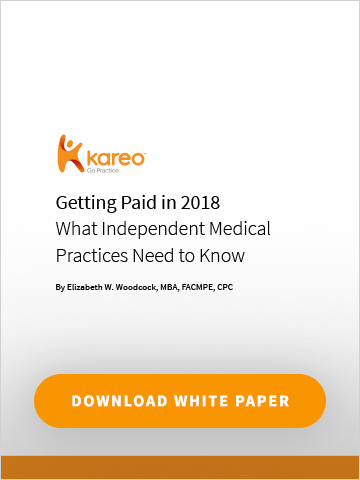(White Paper) Getting Paid in 2018: Finding New Revenue Paths for Independent Medical Practices
Independent medical practices are in the ideal position to glean additional payments from payers. That statement may shock you, but let’s understand the context. There are many legitimate opportunities for providing services that patients need, from the familiar menus of ancillaries to the once esoteric-sounding services like telehealth and group visits.
Unlike practices that are owned by or closely tied to hospitals or other organizations, independent practice innovators don’t have to watch their ideas wait in line for months or years behind other organizational imperatives (often, with goals that have little to do with day-to-day practice). There are many realistic and achievable strategies to increase payments without the need for a large cash investment.
Let’s take a look at some areas where many of today’s independent practices are excelling, both financially and medically.
Home Visits
As payers seek more effective strategies to reduce the utilization of high-cost settings like the ER, commercial and government payers are turning their attention to treating patients in their homes. Reimbursement opportunities vary greatly, but there is, at least, a standard method of billing for home visits now. A series of CPT codes that commence with “993” can be applied in a pattern similar to office visits, with various levels and different codes for established and new patients as well as the place-of-service code –12. Reimbursement rates for these codes are typically higher than similar office-based encounters. Review state law and payer requirements and assess your technology needs – like a mobile, cloud-based EHR– to enhance the value proposition of home visits.
Preventive Services
Patient cost-sharing is a challenge. However, payers cover many preventive services in full. Much of the time involved in these services can be performed by other members of the clinical team, so take the opportunity to review the services and determine whether a lower-credentialed member of staff can assist with them. If so, he or she can work to the top of his or her license, allowing physicians and advanced practice providers to optimize their time in performing services that require their levels of expertise and skill.
Find out which preventative services can be performed by other members of a clinical team in order to optimize physician time.
Common Preventive Services Covered by Medicare, With No Patient Financial Responsibility
- Depression screening: once annually, provided in a primary care setting
- Smoking cessation counseling: eight sessions per year (two attempts, four sessions per)
- Face-to-face behavioral counseling for obesity: individual and/or group, 22 sessions per year
- Face-to-face intensive behavioral therapy for cardiovascular disease: once annually, provided in a primary care setting
- Annual wellness visit (AWV): noting the Initial Preventive Physical Examination is to be provided during the initial year of Medicare coverage
- Advance care planning: once annually; no cost sharing when performed with AWV
Visit the CMS website to read more about coverage of these selected services - and other Medicare preventive services that are covered in full.
Telehealth
The Society for Human Resources Management (SHRM) reports an 11% increase over the past year in the prevalence of telehealth as an employee benefit, thanks to more employers offering insurance coverage that includes diagnosis, treatment or prescriptions provided by phone or video (34%).
Most states now have parity laws (or proposed laws) for private insurance coverage for telehealth. What this means is that providers can now bill insurance for routine and follow-up visits via secure video, which increases revenue while decreasing overhead costs. When searching for telehealth technology, be sure it syncs with your EHR and billing software, so you can follow the same workflow as in-office visits within the same software platform. And look for options that don’t require a large upfront financial investment.
Download the free guide, Getting Paid in 2018: What Independent Medical Practices Need to Learn, for more practice success tips and strategies for the coming year.





















